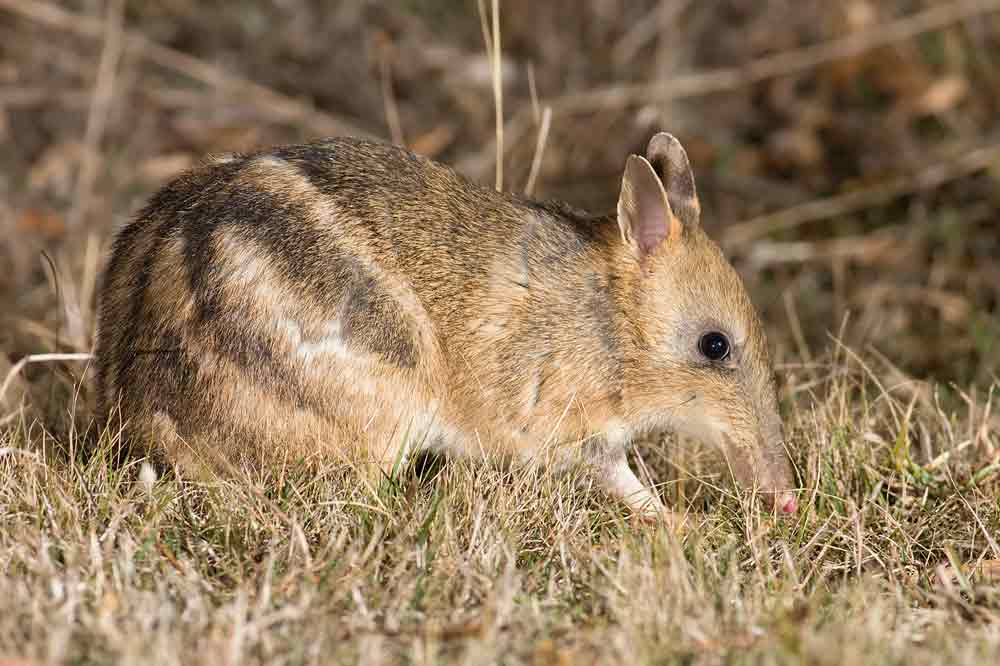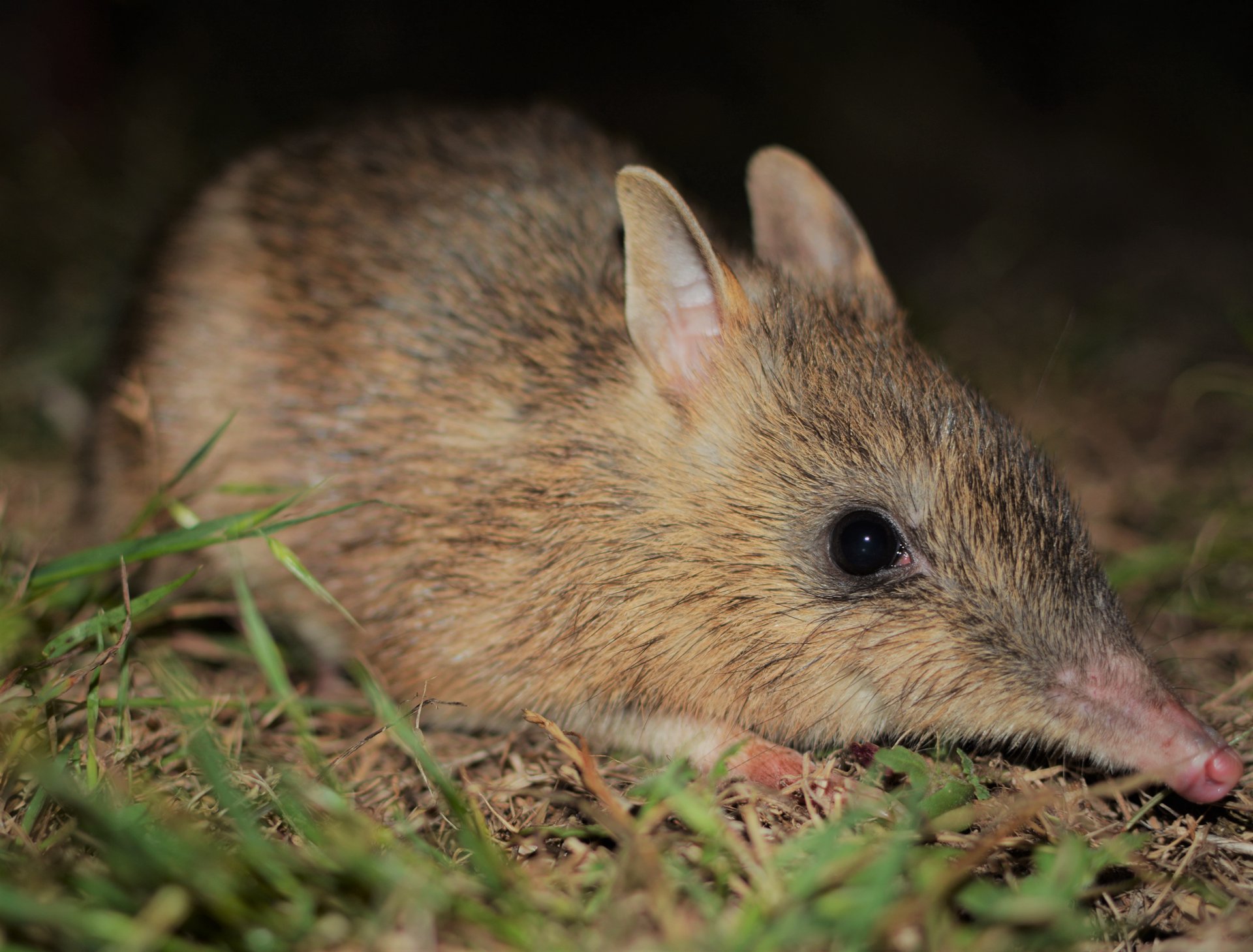The eastern barred bandicoot, scientifically known as Perameles gunnii, is a captivating creature inhabiting the southeastern region of Australia. Resembling a diminutive rabbit in size, this marsupial boasts a distinct nocturnal lifestyle, meaning it is most active during the night hours. Its natural habitat encompasses both the island of Tasmania and mainland Victoria, contributing to its status as an endemic species in this geographical area.
Eastern Barred Bandicoot Profile: Traits, Facts, Range, Diet
The eastern barred bandicoot stands as a testament to the remarkable diversity of Australia’s native wildlife. With its nocturnal habits, distinctive physical features, and vital ecological role, it embodies the intricate tapestry of life in southeastern Australia. While facing challenges to its survival, the bandicoot serves as a symbol of resilience and the importance of conservation efforts in safeguarding our natural heritage.
Physical Characteristics and Habitat
Measuring about the size of a rabbit, the eastern barred bandicoot exhibits a unique set of physical traits that distinguish it within the marsupial family. With a sleek coat and petite stature, it navigates its environment with agility and grace. Its habitat, predominantly found in southeastern Australia, includes a variety of landscapes ranging from dense forests to open grasslands. The bandicoot’s adaptation to these diverse environments highlights its remarkable ability to thrive in different ecosystems.
The eastern barred bandicoot, a fascinating creature of the Australian landscape, presents itself as a petite mammal, seldom tipping the scales beyond 2 kg (4.4 lb). Its distinguishing features include a diminutive tail and a distinctive coat adorned with three to four whitish bars stretching across its rump. These markings, akin to nature’s brushstrokes, serve as a signature trait of this endearing marsupial.
Distinct Populations
A noteworthy aspect of the Eastern barred bandicoot’s habitat is the division of its populace into two distinct groups. One cohort thrives on the vast mainland expanse of Australia, while the other finds its niche on the isolated island of Tasmania. This geographical segregation has fostered unique evolutionary paths, reflected in their differing physical attributes and behaviors.
Regional Disparities
Significant variations emerge when comparing the Tasmanian variant to its mainland counterpart. Notably, the Tasmanian iteration dwarfs its mainland kin, boasting an average adult mass of 750 g in Victoria and a more robust 1,000 g in Tasmania. This discrepancy in size underscores the profound influence of environmental factors on the evolutionary trajectory of this species.
Life Span and Social Dynamics
Despite its intriguing physical characteristics, the Eastern barred bandicoot leads a relatively brief existence, typically spanning a mere two to three years. Remarkably solitary in nature, this marsupial eschews gregarious behavior, preferring solitude in its pursuits. Male bandicoots stake out expansive territories, far surpassing those of their female counterparts. Their interactions with females are fleeting, limited solely to the purpose of mating, illustrating a stark contrast in social dynamics within the species.
Nocturnal Behavior and Lifestyle
Under the cloak of darkness, the eastern barred bandicoot emerges from its shelter to embark on its nocturnal adventures. As the sun sets, this elusive marsupial becomes increasingly active, foraging for food and engaging in social interactions within its community. Its preference for the cover of night serves as a survival strategy, allowing it to evade predators and exploit the resources available under the veil of darkness.
Ecological Importance and Conservation Efforts
Within the intricate web of southeastern Australia’s ecosystem, the eastern barred bandicoot plays a crucial role in maintaining ecological balance. As an omnivorous creature, it contributes to seed dispersal and soil aeration, thus promoting the health of its habitat. However, despite its ecological significance, the species faces numerous threats, including habitat loss and predation by introduced species. Conservation efforts aimed at protecting and restoring its natural habitat are underway to ensure the survival of this unique marsupial for generations to come.
Other Recommended Articles
- Norwegian Lemming – Profile | Traits | Facts | Attack | Aggressive
- Gray Fox – Profile | Traits | Facts | Skull | Fur | Tracks | Habitat
- American Mink – Profile | Traits | Facts | Skull | Size | Baby | Tracks
- Arctic hare – Profile | Traits | Facts | Babies | Reproduction | Size
- Laptev Walrus – Habitat | Profile | Traits | Facts | Diet | Threats
- Pacific Walrus – Profile | Traits | Facts | Teeth | Habitat | Habitat
- Atlantic walrus – Profile | Traits | Facts | Teeth | Habitat | Baby
- Mountain Hare – Profile | Traits | Facts | Run | Habitat | Footprints
- European Hare – Profile | Traits | Facts | Call | Skull | Face | Size
- Japanese Hare – Behavior | Profile | Traits | Facts | Snow | Habitat | Diet
- Snowshoe Hare – Profile | Fur | Color | Traits | Facts | Feet | Habitat
- Bat Eared Fox – Profile | Traits | Facts | Skull | Baby | Diet | Teeth
- Ondatra zibethicus – Muskrat – Skull | Tail | Eat | Teeth | Size
- 60 Arctic Fox Fun Facts – Interesting Facts to Know
- All About Arctic Foxes – Facts | Profile | Adaptation
- Domesticated Arctic Fox – Can There Be a Pet Fox?
- Arctic Fox Life Cycle – Stages | Facts | Information
- 50 Arctic Fox Interesting Facts to Surprise Anybody
- 26 Fennec Fox Adaptations and Survival Factors
- Arctic Hare Adaptations and Survival Factors
Eastern Barred Bandicoot Food Habits
The Eastern Barred Bandicoot eats small vertebrates, quite a lot of invertebrates, and a few vegetation. Their primary diet, nonetheless, consists of invertebrates from the soil.
They use their effectively developed sense of odor to find meals. They then use sturdy claws and their long slender nostril to dig small conical holes within the ground from which their meals is extracted.
Food objects embody root-eating grubs, cockchafers, and corbies. They additionally feed on earthworms, beetles, and a few plant materials resembling roots and berries.
Research in Australia reported a high variety of berries within the Eastern Barred Bandicoot’s diet. Perameles gunnii is nocturnal. After nightfall, it emerges from its nest and instantly begins foraging for meals.
Eastern Barred Bandicoot Behavior
Eastern Barred Bandicoot is a solitary marsupial that solely emerges from it is nest at nightfall, or when it’s threatened.
When it’s disturbed it makes a variety of noise, snuffling, squeaking, and hissing attempting to make the hazard go away.
It can transfer extraordinarily quickly, galloping alongside leaping a meter at a time. It can also be recognized to be very aggressive.
Since it’s nocturnal and solitary, the Eastern Barred Bandicoot actually solely forages for meals and breeds.
The sole time that an Eastern Barred Bandicoot will intermix with others of the identical species is when it’s breeding season and they’re in search of a mate.
Most of the day is spent resting in nests, which is often no more than a shallow melancholy within the ground with a dome of grass pulled over the top. Only one adult bandicoot occupies a nest.
Eastern Barred Bandicoot Reproduction
The reproductive price for Eastern Barred Bandicoot could be very high. But the mortality price can also be extraordinarily high, significantly amongst juveniles.
Bandicoots are solitary animals and solely combine with different bandicoots when breeding. In Tasmania, younger are born between late May and December. Females could start breeding across the age of three months.
A feminine could produce as many as 3-Four to litters throughout a breeding season. The widespread litter size is 1-4 younger.
This signifies that a feminine barred bandicoot has the reproductive capability of manufacturing as much as practically 16 younger in a single breeding season.
Young stays within the mom’s pouch for about 55 days. The younger usually stay with the mom within the nest for every week or two after they go away from the pouch.
This is the one time that one will discover an Eastern Barred Bandicoot sharing its nest. The residence range for males is roughly 100 acres ( 40 hectares ), and 75 acres ( 30 hectares ) for females. These territories do overlap.
Eastern Barred Bandicoot Population
Unfortunately, populations at 4 sites at the moment are extinct (Floating Islands Nature Reserve, Lanark, Cobra Killuc Wildlife Reserve, and Lake Goldsmith Nature Reserve), functionally extinct at Woodlands Historic Park, declining at Mooramong, and rising at Hamilton Community Parklands and Mount Rothwell.
The final remaining wild inhabitants, which was as soon as discovered alongside the Grange Burn (a creek) in Hamilton, have additionally been declared extinct. The estimated inhabitant’s size for the Victorian Eastern Barred Bandicoot is 150 people.
Eastern Barred Bandicoot Conservation
Due to predation by launched foxes and cats, together with land-clearing for farming practices, the Victorian subspecies is critically endangered. Since 1989, eight reintroduction sites have been established throughout the bandicoot’s former range.
The conservation of Eastern barred bandicoots in Victoria now relies upon upon the success of captive breeding and reintroduction applications.
Keys to this conservation plan embody sustaining an insurance coverage inhabitants in captivity, conducting analysis to enhance breeding and reintroduction success, and rising community consciousness and help for this uncommon marsupial.
A management plan, developed in 1987 and revised in 1989, advisable the first reintroduction of the eastern barred bandicoot in Victoria at Woodlands Historic Park, 20 km northwest of Melbourne.
Animals have been translocated from the final remaining free-ranging mainland inhabitants in Hamilton, Western Victoria to captive breeding amenities at Woodlands to ascertain a population in 1988.
The captive-bred offspring fashioned the basis for reintroductions into the Nature Reserve, often called the Back Paddock, a 400-ha part of the park with a predator-resistant fence to maintain out feral predators.
Other Recommended Reading
- Striped Polecat – Profile | Traits | Facts | Pet | Poop | Baby | Range
- Red Panda – Behavior | Profile | Traits | Facts | Baby | Cute | Range
- Malayan Weasel – Profile | Traits | Facts | Range | Habitat | Size
- Asian Badger – Profile | Traits | Facts | Behavior | Diet | Range
- Nilgiri Marten – Animal | Profile | Traits | Facts | Baby | Cute
- Indian Mongoose – Profile | Animal | Habitat | Traits | Distribution
- Collared Mongoose – Profile | Traits | Facts | Behavior | Range
- Burmese Ferret-Badger – Profile | Behavior | Traits | Facts | Range
- Javan Ferret-Badger – Profile | Traits | Facts | Range | Diet
- Vietnam Ferret-Badger – Profile | Traits | Facts | Behavior | Diet
- Patagonian Weasel – Profile | Traits | Facts | Behavior | Range
- Palawan Stink Badger – Profile | Physical Characteristics | Classification


